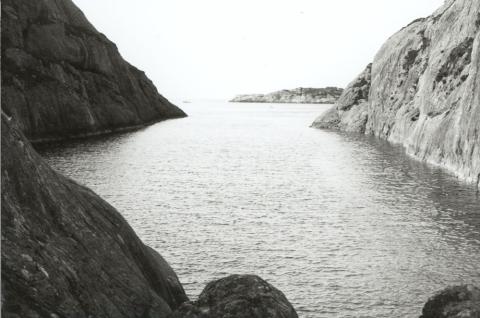As if made for clandestine missions
Two narrow bays meet and almost cut off a part of the southernmost tip of the island of Oldra. It has good lobster places, and deep enough water close to steep cliffs for a vessel to dock, unless wind from the sea or waves from the south make this impossible. The bay of Djupevågen from the south is more visible. Nonetheless, here was the covered bunker facility for the MTB (motor torpedo boat)345 on its two missions to Solund. There were some extra jerry cans with petrol on the first trip: they were hidden in the turf, and were more than welcome on the second trip. Local people at Indrøy were useful and essential contacts.
In this cave, innermost in the bay of Humrevågen, there was a well-hidden arsenal of about 200 packages of arms and ammunition.
The bay of Humrevågen is too narrow for an MTB to turn. The arms cargo was probably taken ashore by a smaller boat, unless it was done on a night when the sea was calm.
Not for otter and mink only
The narrow bay of Humrevågen, which cuts in from the west, faces the open sea. Even a small navy vessel has hardly anything to go on here. On one side innermost in the small bay, there is an open, creepy cave in the rock, where otter and mink thrive. Here, under moss and heather, there was in 1944 a rich arsenal of arms hidden, which was disclosed by information in an intercepted letter to Peder Furubotn. The letter contained information that a man from Solund, Schrøder Evensen, had and could point out two arms depots in Solund. So the hunt for Schrøder started, secretary of the Communist Party for western Norway and thus particularly well informed and active in the resistance movement.
Hands tied behind his back
A Nazi fishing vessel from Bergen arrived for the sole purpose of tracking him down at Enstad. The Germans climbed over rocks and cliffs and unexpectedly came across Schrøder while he was haymaking. He had decided to drop by briefly at home and make hay for a couple of days before leaving the country. Schrøder was hanged by his hands tied behind his back, on a door. - But not for long, the interpreter Lauer later testified, only for fifteen minutes to half an hour! Confronted with the disastrous letter to Oslo, the battle was lost for Schrøder. In the afternoon the vessel was on its way to Oldra. Evensen was expected to point out the arms depot. When they found it, the Germans sent for people from the neighbouring island to load the materials onboard.
Jumped overboard
A youngster from Bergen, forced along on this mission by the Germans, counted 193 packages of weapons and ammunition when they transferred the catch on to a navy vessel at Nåra. But Schrøder was nowhere to be seen.
In the evening darkness, somewhere in the sea-lane from Oldra to Nåra, he saw his chance to jump through the wheelhouse and overboard from the Gestapo vessel. - Don't shoot! the police chief shouted. The extremely valuable prisoner for German intelligence could not be found in the searchlight. Many resistance members could thank him for taking all he knew with him into death. Schrøder Evensen lost his life that night, between 7 and 8 September 1944.


